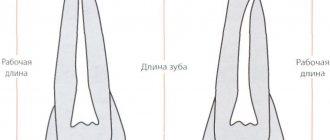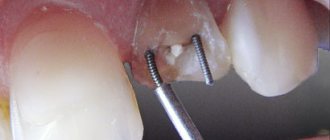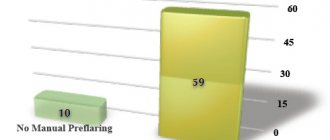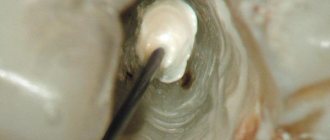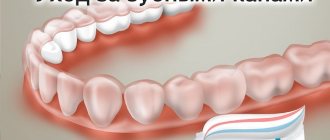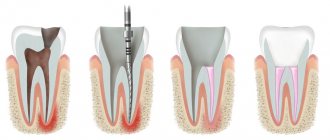Resorcinol-formalin method of root canal filling
This method involves the transformation of the pulp or its decay in the impassable part of the root canal into a plastic-like aseptic strand that is not subject to dissolution or decay under the influence of microflora and tissue fluid.
First, the carious cavity is prepared, the tooth cavity is opened and endodontic access is created. After this, the patency of the root canals is determined. Well-passable canals are mechanically and medicinally treated and sealed.
Pregnation with a resorcinol-formalin mixture is carried out in three to four visits. When carrying out the resorcinol-formaldehyde method, the contents of the root canal are impregnated with a resorcinol-formaldehyde mixture, which, after using a catalyst, polymerizes into phenol-formaldehyde plastic. As a result, the pulp, together with microorganisms, appears to be immured in this glass-like mass that does not decay. During the polymerization process, this mass shrinks, moving away from the canal walls and apical foramen, so the resorcinol-formalin method does not guarantee sealing of the canal lumen. To reduce shrinkage, the passable part of the canal should be filled with resorcinol-formalin paste.
After the resorcinol-formalin method, the tooth turns pink; when it penetrates the apical foramen, the resorcinol-formalin mixture causes irritation of periodontal tissue.
Effect of endodontic solutions on resorcinol-formalin paste
Author: Ronald N. Vranas
This study determined the ability of any of four endodontic solutions to have a softening effect on resorcinol-formalin paste, as well as what differences exist between the dissolving capabilities of these solutions. Resorcinol, formalin and zinc oxide were mixed and left for 30 days. Test solutions: 0.9% sodium chloride, 5.25% sodium hypochlorite, chloroform and Endosolv R. Seven solution samples were tested and an additional seven served as controls. Each sample was saturated with one of the solutions, and the penetration depth was tested after 1, 2, 5, 10 and 20 minutes. using a strain gauge. After 2 min. hypochlorite and sodium chloride solutions had significantly better penetration than other samples (p<0.0010). Sodium hypochlorite was superior to all other solutions after 5 min. This study shows that both hypochlorite and sodium chloride have a significant softening effect within 2 minutes.
The main goal of filling root canals is to fill the root canal system three-dimensionally. Grossman stated that the ideal root canal filling material should be easy to insert into the canal, fill the canal laterally and apically, should not shrink, be resistant to washout, be bacteriostatic, be radiopaque, should not stain the tooth structure or irritate the periapical tissue, should be sterile before insertion and also be able to be easily removed from the root canal if necessary. Despite this, gutta-percha, in any of the presented forms, although it does not meet all the above requirements, is still considered the best obturation material for root canals.
The pastes that were used for filling root canals were zinc oxide eugenol (ZOE) or resin-based (without ZOE). Due to the lack of apical control and release into the periapical tissues, which are subsequently exposed to toxic effects, the pastes have not been highly regarded as a suitable root canal filling material.
Some eastern bloc countries, mainly Russia, still use pastes to treat pulpitis. Although there are many variations of pastes used, their main component is resorcinol. This material is a white crystalline powder that turns pink when it comes into contact with air, light or metal. The mixture used to fill root canals is made of resorcinol, zinc oxide and formaldehyde. These three ingredients are mixed together to form a paste, which is then applied to the root canal. Once cured, this material creates a virtually impenetrable barrier and changes the color of tooth structures to shades of red or pink. As a rule, this paste is placed without adequate treatment of the root canal from decay, which subsequently leads to the appearance of periapical pathologies in many teeth. If these teeth are to be saved, they require retreatment or apical surgery. Since the migrating population
Silver plating method for root canal filling
The silvering method involves soaking the impassable part of the root canal with silver nitrate. After the restoration of silver, a thin film of metallic silver (“silver mirror reaction”) is deposited on the walls of the micro- and macrochannels, “burying” the microflora in the thickness of the dentin. As a result of the interaction of silver with pulp proteins, silver albuminates are formed, which “preserve” the pulp, turning it into an aseptic strand that is not subject to putrefactive decay. In addition, the presence of silver in the canal, which has a long-term antiseptic (more precisely, oligodynamic) effect, prevents the growth of microflora and the development of inflammatory complications from the apical periodontium.
Impregnation using the silvering method is also carried out in 3-4 visits.
Resorcinol-formalin method of dental treatment
In 1912, a German dentist from Frankfurt am Main, Julius Albrecht, proposed resorcinol-formalin paste for the treatment of complicated caries.
The composition of the treatment mixture included only two components: resorcinol and formalin. The resorcinol-formalin method is not a pathology, but is an outdated method of dental treatment with a “lot” of side effects. In the same Germany, the progenitor of the method, the material Resorcinol was discontinued more than 50 years ago.
The method is based on the bactericidal and mummifying properties of this mixture, due to which the decay of the incompletely removed pulp on which this mixture is applied is stopped. The mixture slowly hardens in the tooth canals, which was thought to seal them.
Clogging the dental canals, this mixture hardened and became glassy. The method turned out to be cheap, easy to use and became widespread due to the fact that it did not require special skills from specialists. But after some time, the tooth treated in this way acquired a reddish tint, became fragile and often caused problems for the patient. That is why it was and is necessary in the vast majority of cases to re-treat the resorbed tooth. In fact, it turned out to be a poor and short-lived therapeutic solution.
Combination of silvering method and resorcinol-formalin method
To increase the efficiency and reliability of impregnation methods, it was proposed to combine the silver plating method and the resorcinol-formalin method. In this case, the silvering method is first carried out, in which the walls of the micro- and macro-channels are covered with a film of metallic silver. Then impregnation is carried out with a resorcinol-formalin mixture, as a result of which the pulp in the impassable part of the root canal turns into an aseptic plastic-like strand that is not subject to dissolution or decay under the influence of microflora and tissue fluid.
Why re-treat such teeth?
The use of resorcinol-formalin mixture has several disadvantages:
- It does not provide a hermetically sealed root canal filling. Because of this, the infection may gradually develop or recur even after careful treatment.
- Formalin is hygroscopic. It “pulls” moisture from bone tissue, which becomes fragile and brittle because of this. Dentin also becomes fragile. It loses strength so much that it easily crumbles under dental instruments.
- Due to the toxicity of the components of the mixture, after filling, gum atrophy, recession of the soft tissues surrounding the tooth, and exposure of the root neck may begin.
- Filling with a resorcinol-formalin mixture kills the nerve, and there is no pain in the tooth treated in this way. If the inflammation continues, there are no symptoms for quite a long time. Noticeable signs appear already at the severe stage.
- Due to the individual components of the mixture, the color of the dentin changes: it can become dark, gray, brown or pinkish. Stained dentin shines through the enamel, changing its shade so that it stands out sharply in the dentition. Bleaching does not help restore the original shade of enamel, and due to the fragility of hard tissues, it is dangerous to use.
More than 50% of teeth treated using the resorcinol-formalin method require retreatment several years later. If the filling was not performed to the root apex, in 80% of cases bone tissue destruction occurs, which also requires re-treatment.
Mummification of the contents of the impassable part of the root canal
The term “mummification” in dentistry refers to the prevention of microbial decomposition of the pulp by impregnating it with potent antiseptics (thymol, camphor, iodoform, cresol, parachlorophenol, etc.). For this purpose, a cotton swab moistened with potent, slowly dissolving antiseptics, or a paste containing mummifying substances, is placed into the tooth cavity at the mouth of the root canals, and the tooth is sealed. This method is currently practically not used due to its low efficiency.
Problems of retreatment of resorcinol-formalin teeth
If a source of infection persists in the area of a tooth filled with a resorcinol-formalin mixture or inflammation occurs again, difficulties in retreatment arise at the next stages.
Diagnostics. The hardened resorcinol-formalin mixture is not visible on x-rays: in the images, filled root canals look empty. Because of this, it is impossible to assess the quality of the filling, see pores, voids or leaks. This makes it difficult to assess the condition of hard tissues and prepare a treatment plan.
Unsealing of root canals. It is needed for re-treatment. Normally, the old filling material is removed, sanitation is carried out, and re-treatment is performed. If a resorcinol-formalin mixture was used, unsealing becomes more difficult. It can be performed mechanically (rotating instruments are used), or chemically (a good result is obtained by using Endosolve, a special liquid for unsealing). Most often, it is necessary to combine these methods, unfilling the root canals gradually, in several stages.
Preparation. When preparing for treatment at the preparation stage, there is a high risk of perforation (the appearance of a through hole). This is due to changes in the structure of the bottom of the cavity, difficulties in diagnosis using radiography, and changes in the color of dentin.
Filling or prosthetics. Complicated by the high fragility of hard tissues. In some cases, hypercementosis develops: excessive deposition of cement on the tooth roots. This complicates both filling and tooth extraction.
Resorcinol-formalin method or the story of one tooth. Patient's view.
N.I. KUDRYA, specialist of the medical standards department
Probably every person at least once in his life has had to deal with a toothache that does not go away for a minute, gets worse from hot, cold and becomes especially severe at night. This happened to me once too. I tried to relieve the pain with a pill. But neither after the first nor after the second pill the pain disappeared. After spending the night, I went to the dentist in the morning. The doctor diagnosed it as pulpitis.
Pulpitis is the result of penetration of pathogenic microbes into the dental pulp, causing its inflammation. Pulp is the loose soft tissue that fills the dental cavity, consisting of many nerves, lymphatics and blood vessels.
Sitting in the dental chair, I thought only about one thing - to quickly get rid of this torment. Then I didn’t even think about what method I would be treated with. At that time, pulpitis of chewing teeth was treated in one way. A paste containing arsenic was placed into the tooth pulp. The patient left only to return 2–3 days later. During this time, the paste killed the nerve, the tooth became insensitive. At the next visit, the dead pulp was removed, and the canals were filled with the resorcinol-formalin method. At the end, the doctor put a permanent filling, and the patient went home happy, which I did too.
Once, during a routine examination, the dentist recommended that I put a crown on that same tooth. I agreed. The doctor also advised me to treat the root canals to make sure that there are no inflammatory processes in them. To do this, it was necessary to unseal the canals, treat them instrumentally and medicinally, and seal them again. During the retreatment, I learned that my tooth had previously “tested” the resorcinol-formalin method. It turned out that it is now impossible to properly treat the canals. The paste that was in the tooth cavity has turned into a solid mass that cannot be passed through with an instrument. In the end, the tooth was “crowned” with a crown with no guarantee that future complications would not arise.
I wanted to know more about the resorcinol-formalin method. At that time, not being a doctor by training, I was already working in a dental center and could get information from personal conversations with specialists.
The method of filling canals using formalin saturated with resorcinol was proposed in 1912 by Dr. Albrecht. According to the author, the mixture had bactericidal and mummifying properties. Followers began to believe that the mixture solidified in the channels, reliably sealing them. For that time it was a truly progressive method, because... It became possible to save diseased teeth - previously they were simply removed. In addition, it turned out to be inexpensive and quite easy to use, which also played a role in its wide distribution.
Today, practice shows that resorcinol-formalin paste does not always completely fill the canals, and this can be seen on x-rays. Foci of inflammation remain, which leads to complications and the need to re-treat the tooth. The retreatment process is quite complex and not cheap for the patient. In addition, the likelihood that retreatment will be successful is low. There is also an aesthetic drawback - the “resorcinol-formalin” tooth acquires a pinkish-brown tint. In addition, the dangers of using the resorcinol-formalin method have been proven by many years of research. Formaldehyde and resorcinol are toxic substances. Formaldehyde, the active ingredient in formalin, gradually spreads throughout the human body and has a negative effect on the reproductive organs, central nervous system, respiratory tract, skin, and eyes.
In many countries around the world, the use of the resorcinol-formalin method in dentistry is prohibited. For example, in Switzerland it has not been used for more than 70 years. In the United States, a doctor who offers this method to a patient is deprived of his license. In our country, some municipal dental clinics still use the resorcinol-formaldehyde method of root canal treatment, despite the fact that safer and more reliable methods exist. The reason for its indestructibility is the same cheapness and the lack of opportunity or desire among Russians to pay for high-quality dental treatment.
It often happens that a person is faced with the need to make a choice that is difficult to make correctly without having the necessary information, especially when it comes to health. In this article, I wanted to talk about the resorcinol-formaldehyde method, without using medical terms, from the perspective of a patient who has experienced the consequences of its use. I hope I succeeded.

